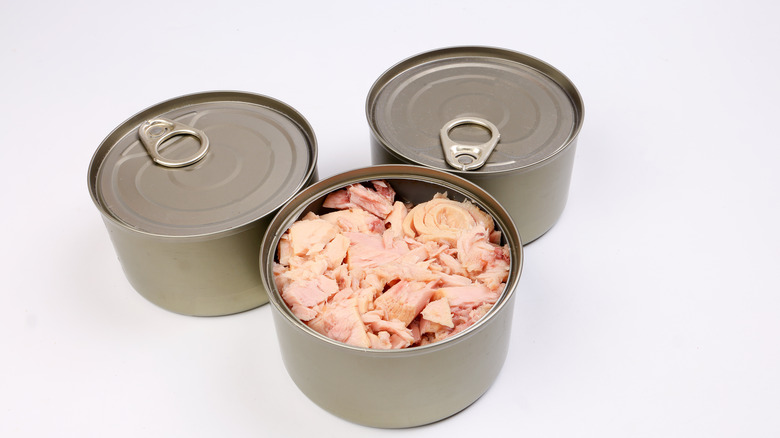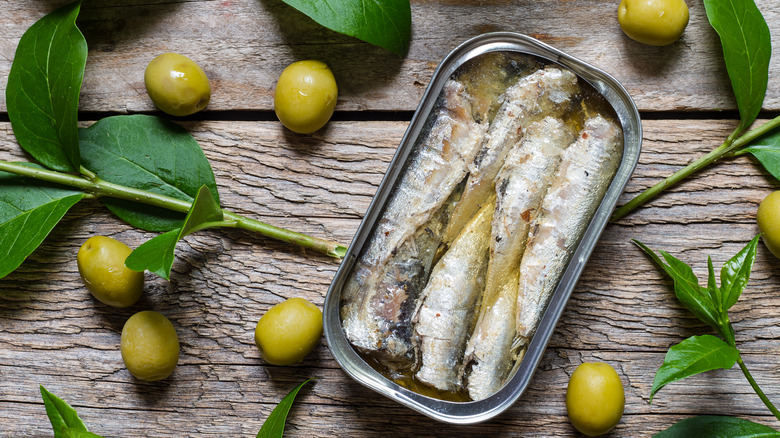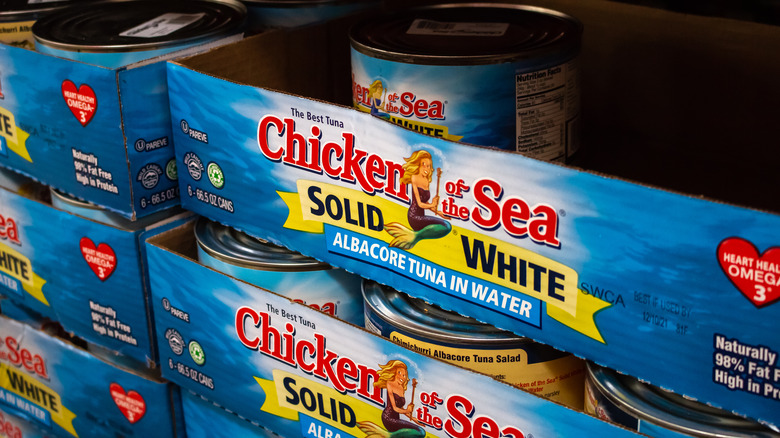What Is Canned Fish And Is It As Nutritious As Fresh?
Canned fish, or "tinned fish" as it's sometimes called, is not a modern invention. You might think that StarKist or Bumble Bee tuna invented the concept, canned fish has actually been around since the 1800s. Per Science Direct, canned fish is fish that has been processed, sealed in a container that is devoid of air, and heated to kill any microorganisms. Britannica explains that canning was invented by a Frenchman named Nicolas Appert in 1809. Appert's invention was a response to the French government's need to keep food for its military from spoiling.
But Appert didn't use a can. The French man used glass bottles to accomplish his feat. As time progressed, bottles made way for tin-coated iron cans in the 19th century, and by the 20th century, aluminum cans became the "it" container for this food. Fast-forward to the present, and canned fish is being overtaken by plastic pouches, per Plastics Make It Possible. But what exactly is this ingredient used for and does it taste good? Sorry, Charlie, but inquiring minds want to know.
How is canned fish made?
First, a brief primer on how canned fish is made. According to Science Direct, our favorite canned fish — tuna, salmon, sardines — are thermally heated or processed at a temperature between 113 and 160 degrees Celsius. But before they're processed, Michigan State University explains they are washed and cleaned. To create just 12 pint-size jars or cans of fish, it takes a whopping 25 to 35 pounds of whole, fresh fish. The university also shares that brining is recommended before canning takes place.
Why? It helps the fish retain its firmness and freshness. However, before your fish is sealed up in an airtight container, that brine is poured off. Once our favorite seafood has been packed in its can, a pressure canner is used to reduce the "risk of botulism and food poisoning." This is the point where all of those pesky microorganisms are killed. What are the advantages of pressure canning?
The pros of pressure canning
According to the Well Preserved blog, pressure canning offers several advantages when it comes to canning your favorite fish. First, it heats food to such a high temperature that it eliminates the need to add acid to kill any bad organisms that might contaminate the fish. Beyond the safety element, it also allows foods to keep their taste. Preserving fish in this manner allows us to enjoy the seafood whenever we want to. However, A Traditional Life shares that when you can fish, its texture can change and become a little softer. But they also offer a pro tip: bigger fish also equate to firmer fish when canned.
The Food and Agriculture Organization of the United Nations notes canned fish has a substantial shelf life. Unopened canned fish, when stored properly, can last anywhere from one to five years, making this an ideal protein to keep in your pantry for both planned and unplanned meals. What kinds of fish do we can?
Types of canned fish and where to buy
According to the Food Print blog, the National Oceanic and Atmospheric Administration says that people in the United States consume, on average, 16 pounds of seafood each year. Of those 16 pounds, almost 4 pounds originate from a can, and only one third of that canned fish isn't tuna. Yep, tuna is by far the preferred canned fish. But The Spruce Eats suggests salmon, anchovies, mackerels, and sardines are also quite tasty and worth featuring in your pastas, salads, pizzas, and chowders. The site also explains that in the Mediterranean region of the world, canned fish variations are even greater and are considered a "delicacy."
Octopus, crab, scallops, and squid in a can are all traditional seafoods that people in countries outside America enjoy. And of course, most the of fish we do eat can be found in your local grocery store, which simply adds to the convenience of this pantry staple. Which leads to the next question, what does canned fish taste like?
What does canned fish taste like?
Because there is such a variety of canned fish, there is also a variety of tastes and smells associated with them. The New York Times laments that tuna, which is exceptionally popular in the United States, can be "inconsistent" when it comes to taste and texture. And because the tuna can be from just about anywhere, sometimes you aren't getting straight-up tuna. In fact, the news outlet notes that canned fish can contain up to 18% of other fishy ingredients, and during a taste test of 14 different cans of this seafood, one taster responded, "It is amazing that tuna has so many different tastes."
The blog Food Lve characterizes the taste of this seafood as pretty "meaty," "oily," and "dry." But you can expect canned tuna to be saltier than fresh tuna because of the brine it was processed with. Of course, the smell may make this food a nonstarter. According to the Kitchn, even Wolfgang Puck couldn't help but show his disdain for canned fish during an episode of "Top Chef Duels." But if you enjoy a good tuna salad sandwich or like to add small fish to your favorite Caesar salad, canned fish is definitely the economical way to go.
Nutritional value of canned fish
Canned fish is considered a nutrient-rich source of nutrition. Science Direct explains that canned fish is full of protein and can provide your body with omega-3 fatty acids. These fats, according to the Cleveland Clinic, are fats our body cannot make on their own and are deemed essential to proper functioning. A diet that contains fish is said to help lower the risk of heart disease and keep blood pressure down. But per Taste, make sure to be on the lookout for high sodium content in your tuna. If you opt to have canned salmon, they suggest choosing a brand that contains the bones because it will boost your calcium intake. And don't forget the sardines. These small fish and their omega-3 fatty acids are heralded for helping to improve mental health and for helping to reduce the possibility of breast cancer.
And if you're wondering if fresh is better than canned, then wonder no more. Per Consumer Reports, neither is outright better than the other when it comes to nutritional value. They go on to share that in a study of canned salmon versus fresh salmon, it was actually discovered that the canned version had a greater amount of those omega-3 fatty acids than its fresh counterpart. Go figure!
Fish canned in oil versus water
What's the difference of fish being packed in oil or water? According to Share Care, oil and water are the two most common liquids that you will find canned fish packed in. Generally, oil, which they note is usually olive oil or vegetable, is going to have more fat than those packed in water.
To illustrate this point, they share that tuna packed in water will have about 1 gram of fat per serving whereas fish packed in oil contains, on average, 7 grams. That's a pretty big swing. It is also important to recognize that some of the omega-3 fatty oil in fish winds up in the oil it is packed in. So, unless you plan on using that oil, you are going to be missing out on the key nutrient in canned fish.
However, Bon Appetit has a counter argument. They contend that canned fish packed in oil is going to be more flavorful and tender. Fish packed in water is going to lose its flavor to the water and taste dry, hence why you need all that mayo for your tunafish sandwich.
What about the mercury found in fish?
But what about the mercury found in fish? Good Housekeeping explains that all fish contain some level of this chemical. As Healthline points out, fish absorb this element from the water and then pass it on to whoever eats it. Generally speaking, the amount of mercury you are consuming when you eat fish is relatively low; however, they also note that the amount of mercury you take in depends on other factors. Specifically, you have to consider what type of fish you are eating and how frequently.
Per the Food & Drug Administration, eating fish two to three times a week is considered healthy, as long as it is fish from their "Best Choices" list. These fish, which include tuna (canned light), cod, clams, shrimp, and tilapia, to name a few, will have the least amount of mercury. Canned fish to eat sparingly include King Mackerel and swordfish.







